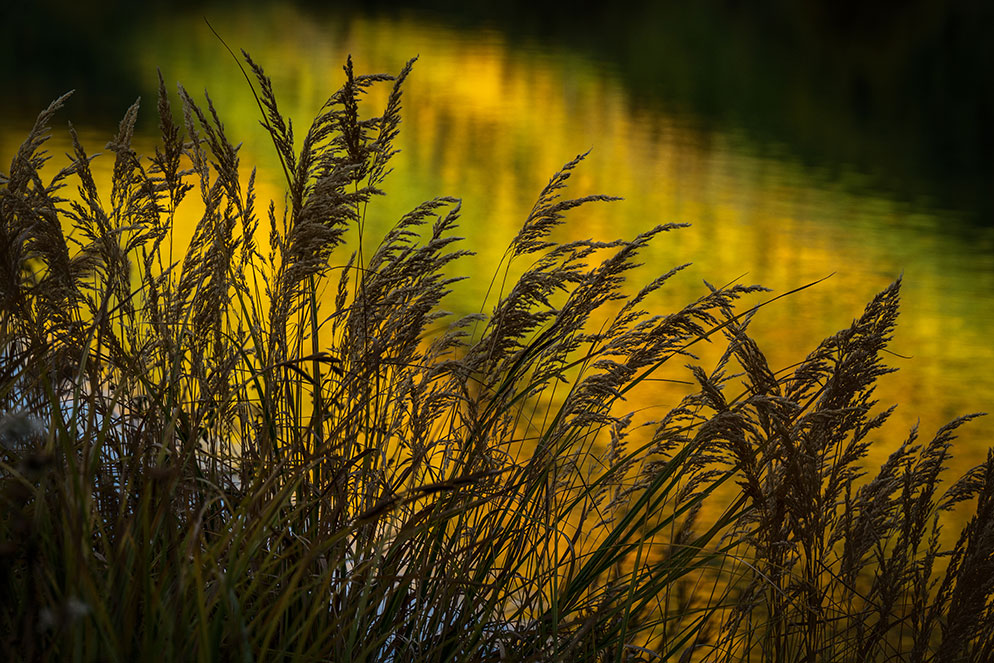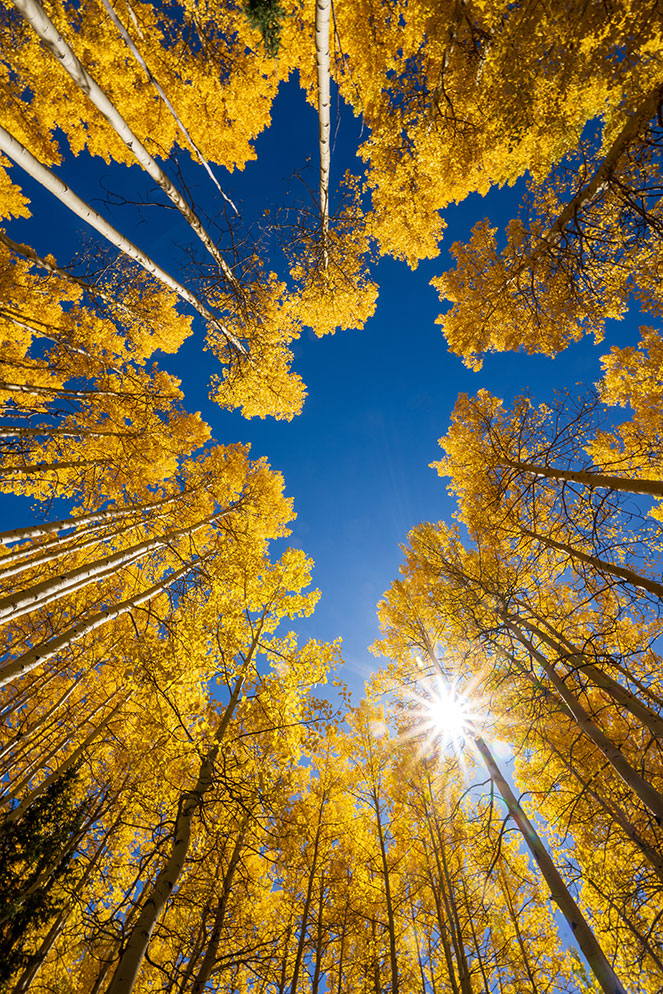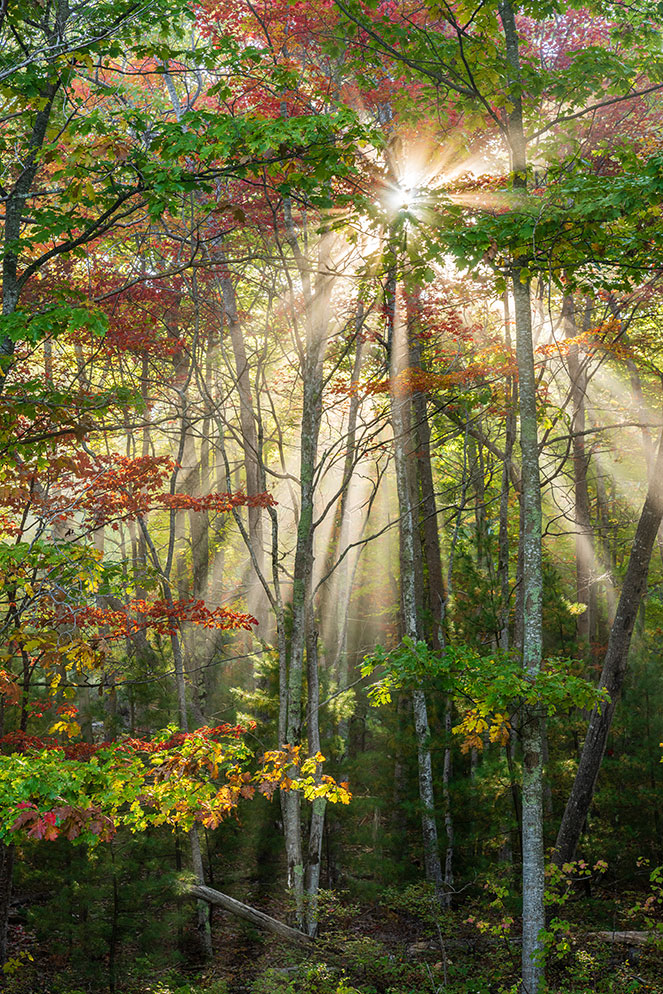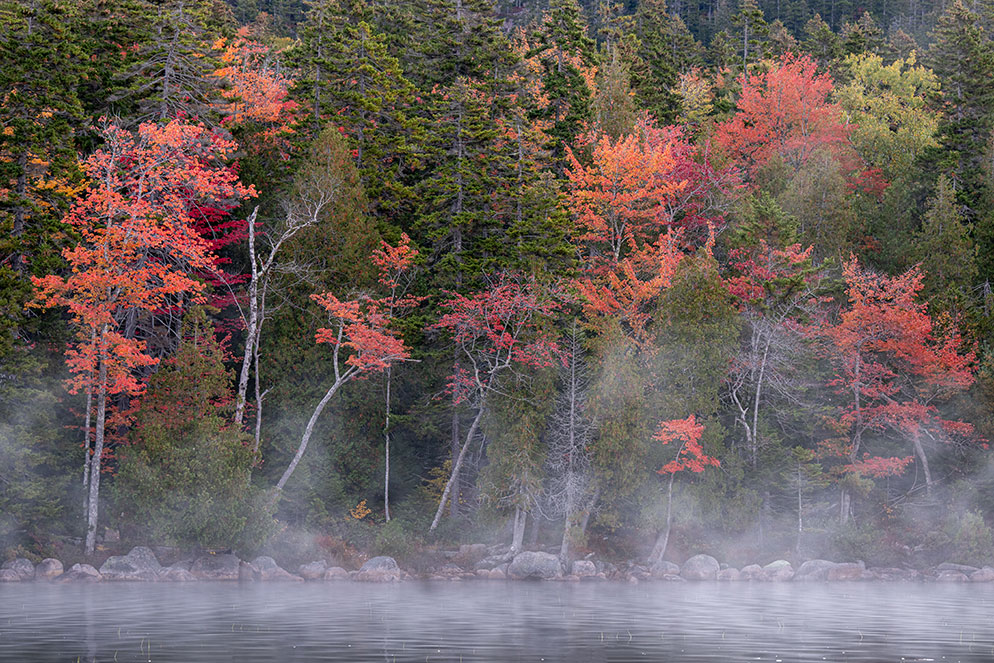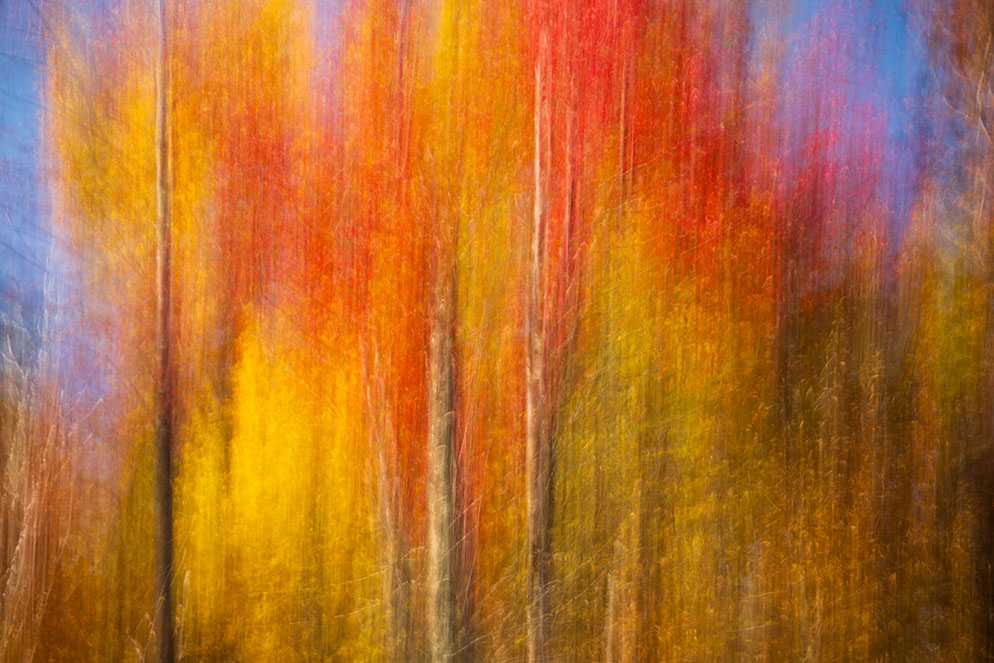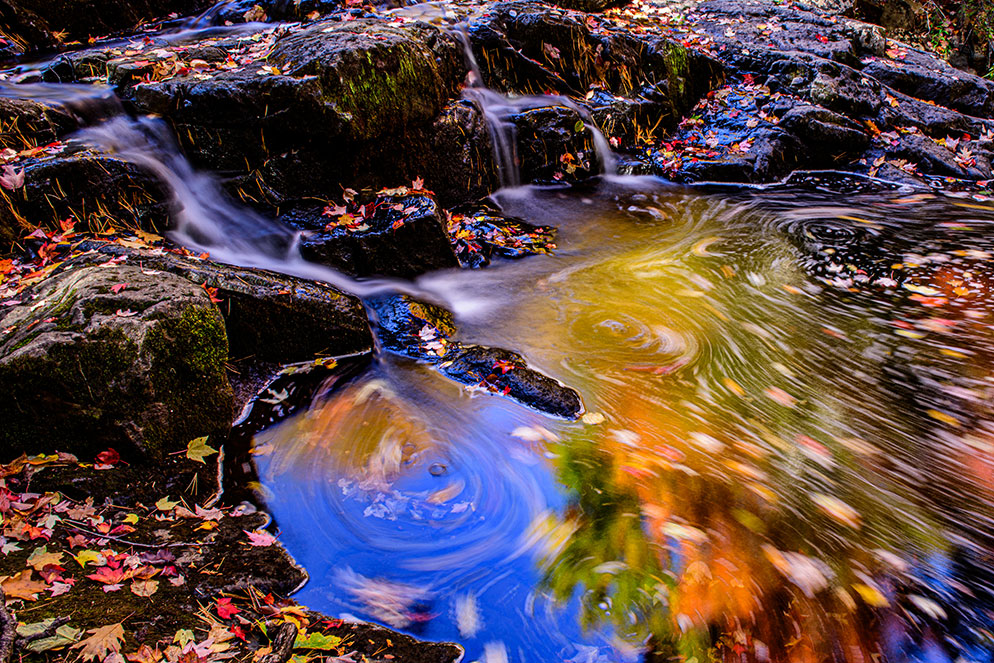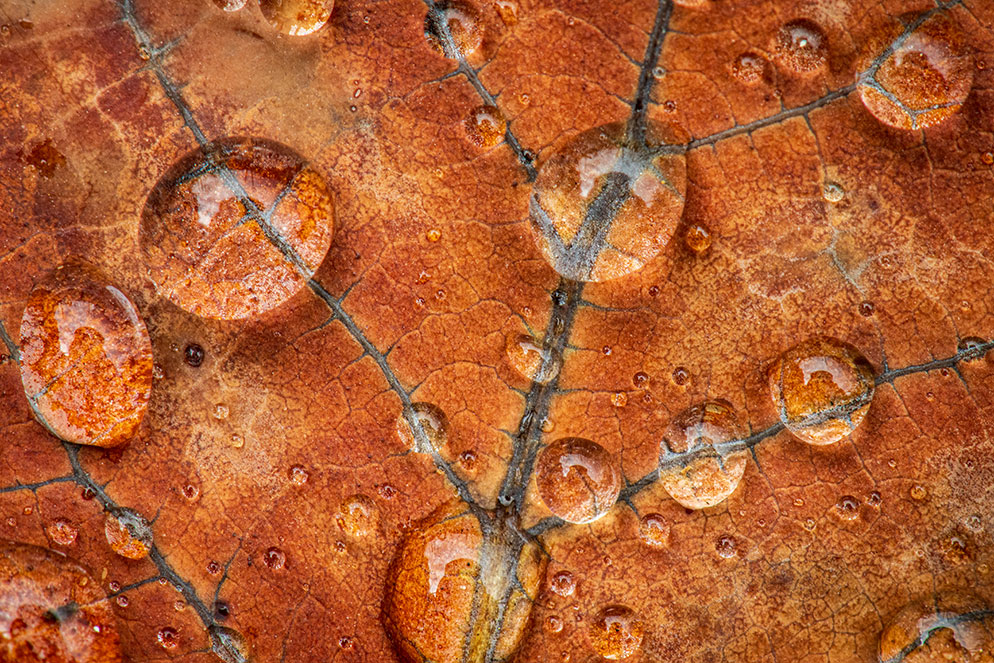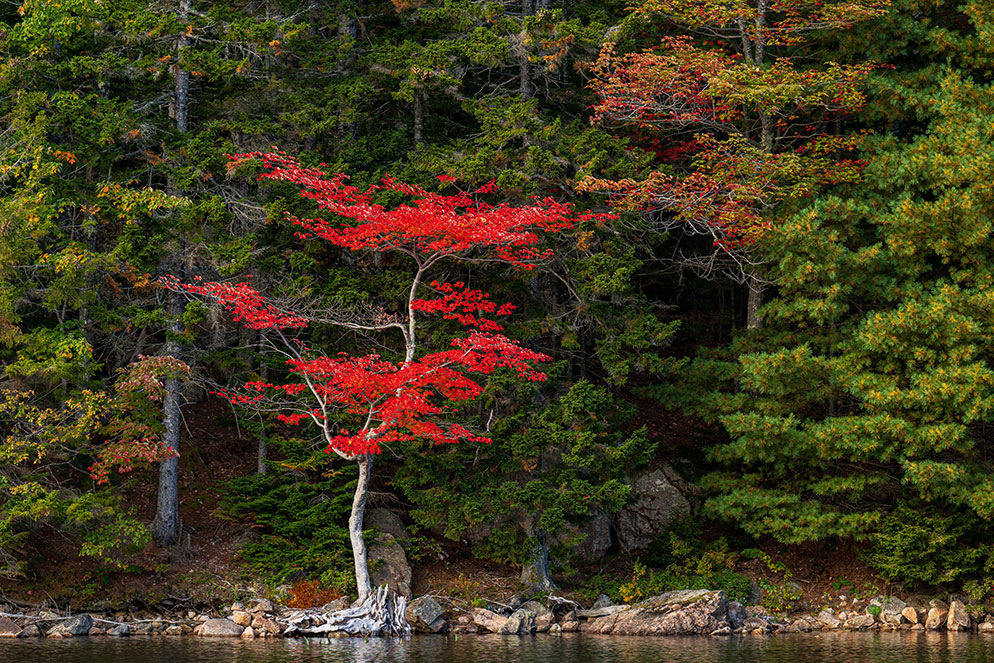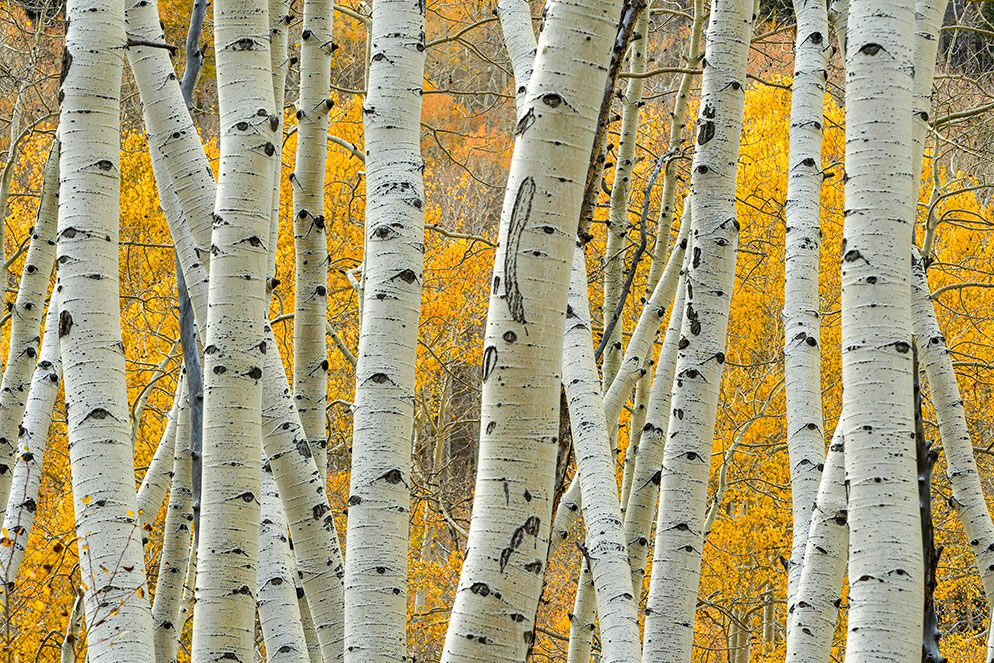Autumn Impressions: Tips for Photographing Fall Color
Acadia National Park, Maine. Who says dead trees don’t look good. I found this scene in a remote part of the park and was instantly struck at the juxtaposition of dead trees over colorful maples. The stark color and pattern of the dead trees creates tension against the colorful healthy trees in the background.
Without a doubt fall is my favorite season. After a long, hot summer, I can’t wait for crisp temperatures, bugling elk and of course, vibrant fall colors. We have aspen trees in our backyard, and at the first sign of yellow I head into the Colorado high country searching for golden stands of trees. Landscapes transform from drab green hues to radiant yellows, oranges and reds. Nature celebrates with one more explosion of color before the long, snowy winter arrives.
Autumn has always been a popular season for photographers. A simple red maple leaf can present beautiful compositions and hours of enjoyable photography. You don’t have to go far. Local parks and open spaces often have gorgeous fall photography opportunities. Even in the middle of busy cities you can find trees transforming from green to red and yellow.
Crystal Lake, Ouray, Colorado. The lake had vibrant reflections on the sunny hillside on the west side. I found this silhouetted grass to break up the reflection and add some tension to the shot.
What is the best approach to photograph fall color? One wonderful aspect of autumn photography is the personal discovery in image making. Find any forest with peak fall foliage and start exploring your creative vision. Honestly, I can’t think of anything else I would rather do than peacefully wander through a stand of yellow aspen creating images. No crowds, no busy overlooks, just you, your camera, and the forest. With no preconceived shots I can really explore new perspectives and angles.
But fall foliage can be challenging to photograph. One comment I often hear on my fall photography workshops is that the scenes are overwhelming. Participants struggle to make sense out of big landscapes with so much color and busy subject matter. But with a little direction, any photographer can create wall-hanger images. Below are some tips to help you get the most out of your autumn photography. Start planning your fall photography adventure now...before the snow flies.
Ridgeway, Colorado. Colorado is most known for stands of yellow aspen, but in southwest Colorado the Gambel Oak changes to hues of orange and red. I love how the triangular juniper trees create a pattern over the colorful oak bushes.
1. Go at the right time. If you don’t have color, then it is hard to create vibrant autumn photographs. Most states have online fall color reports and maps of areas to visit. If I photograph in Denali National Park, fall color is at the peak around September 1. But in Acadia National Park color is generally good into mid-October. I’ve found fall color happens about a week later than it did twenty years ago. But every year is different, and early season storms can mix things up. Consider the elevation of the area you’re photographing. I often go to Ouray, Colorado at the end of September for peak color. But the locations range from 7,000 to 11,000 feet. I might find great color up high and very little color at lower elevations. Spend a little time researching the area you're going to be photographing. It will improve your chances of finding peak color.
Red Mountain Pass, Ouray, Colorado. Shooting up at canopies on blue sky days is one of my favorite fall images to make. Using a small aperture opening like f/16 produces a nice sunstar or starburst.
Acadia National Park, Maine. This was a special morning. We drove down a small winding road and encountered some morning fog hanging in the trees. The sun had just illuminated the scene from behind, creating beautiful beams of light. I photographed vertically to enhance the length and effect of the rays.
2. Light matters. I start my autumn photo workshops by telling participants one of my golden rules of landscape photography: “The first three minutes are the most important.” What does this mean? Landscape photographers rely on the sun to illuminate scenes. You can’t control where the sun goes or how long it stays there. When the sun first crests the horizon, beautiful light rakes across the landscape. This low angled light is rich, warm and textured. The scene will have shadows and dimension in the first moments of illumination. This is the moment to be shooting away! Don’t lose touch with how important light is to your image. Explore different angles of light. While front lit scenes look great, how about photographing backlit maple leaves? Shoot straight up into the canopy using a wide-angle lens and create a sunstar [starburst] (shoot at f/16 or f/22 for best results). Most fall leaves are translucent, so don’t miss backlighting opportunities.
Acadia National Park, Maine. Complimentary colors always catch the viewer’s eye. The brilliant maple trees looked so delicate against the deep green evergreens, and the fog added mystery to the scene.
3. Capture emotion. Often the most powerful images have strong emotional elements. This is easy to imagine with people and animals, but how does this work with trees and colorful leaves? Strong graphic design elements will stir emotions in the viewer. For example, the color red can invoke warmth and love, while blue conveys cold and indifference. Fog can create mystery or foreboding, while beams of light can signify hope. Try this experiment. Set up to photograph a scene before sunrise. Start taking pictures well before the sun comes up and continue photographing the scene until long after sunrise. Now compare images from different times (and lighting) during your shoot and see if they have different moods and emotions. Every landscape goes through a full range of emotion between sunrise and sunset, we just have to photograph it at the right moment in the right mood.
4. Choose the right aperture. My default shooting mode for landscapes is aperture priority with AF-area mode set to 3D Tracking autofocus on my Z 9. For many scenes I find that aperture is the most important variable to control. Aperture controls depth of field, which is very important to landscape photography. If you want the entire scene sharp, you may use an aperture of f/16. But sometimes photographing single leaves in the forest, I like to shoot at f/2.8 to blur the background and eliminate distractions. Remember the viewer’s eyes will go to what is sharp before going to blurry areas of an image. Control the focus point and amount of depth of field to direct the viewer to important parts of your image. I find most of my workshop participants think they need everything tack sharp to make a good landscape image. Not so! Try photographing a scene wide open at f/2.8 and see what happens. Experimentation is critical to improve creativity.
Acadia National Park, Maine. Intentional camera movement (ICM) is all about experimentation and abstract images. These colorful trees were the perfect subject for this technique. I shot at a slow shutter speed and moved my camera up and down in a vertical direction to create this image.
5. Photograph motion. One of my favorite fall photography techniques is intentional camera moment. Set your shutter speed around one second and shake your camera up and down while you take the photograph. You will create colorful abstract images, and you never know what you will get. Try different motions and shutter speeds, there is no right or wrong technique. Also, don’t forget about moving water in your scene. I love to walk along small creeks in Maine in the fall looking for recirculating circles of water, known as eddies. Often these eddies have colorful leaves spinning in circles in the creek. I put a five stop neutral density filter on my lens to slow the shutter speed down to one minute or longer and take the shot. The resulting images can be striking circles of colors and streaks of whitewater. Keep an eye out for ‘motion eddies’, you won’t be disappointed.
Acadia National Park, Maine. A motion eddy…water spins in circles in this little brook, and colorful leaves and reflection add a dimensional quality to the shot.
Ouray, Colorado. One fall in Ouray a huge storm came through and stripped the trees of most of their leaves. I spent the next few days searching for interesting leaves on the ground for macro photography. This leaf had water droplets on it which added more graphic qualities to the image.
7. Look for details. Autumn is a season of brisk change, and that means leaves falling to the ground, the perfect scenario for macro photography. I always bring my 105mm f/2.8 macro lens on fall photography trips. I look for strong color and interesting details on fallen leaves. The best moments are after rain or frost when the leaves have droplets on them. Sometimes I’ll use focus stacking in my camera to create a series of images that can be combined during editing for maximum depth of field.
Acadia National Park, Maine. I call this the perfect maple tree. The beautiful curved trunk and peak red color just pops off the complimentary green background. This scene looked surreal…a perfect maple in a sea of spruce.
8. Patterns and Interruptions. Photographing a big landscape can be challenging, you just don’t know where to point your camera. One trick I use to make sense of the big scene is to look for patterns. Focus on stands of trees and repetition of subject elements. Finding smaller scenes within the big scene will simplify your image and be a good starting point to photographing the grand landscape. Another technique is photographing pattern interrupted, which will attract the viewer’s eye and create more tension in the image. One of my favorite fall shots is a stand of colorful aspen with a single spruce tree peeking out in the middle. This single spruce tree breaks the pattern and color, and creates a more interesting photograph.
San Juan Mountains, Colorado. I was driving on a remote road one year and found this beautiful stand of mature aspen trees in peak color. The pattern of the white trunks just stood out to me. I composed a shot creating tree trunks interlaced against yellow leaves in the background.
9. Line directs the viewer. Here is one more tip to help improve your autumn photography. Line is a cornerstone of graphic design, and using line in your images will help simplify your image. Look for lines in your image that connect the foreground to the background. A winding meadow or stand of trees can create a ‘S’ shaped line that will walk the viewer through your image. On top of Cadillac Mountain in Acadia National Park there are large granite boulders with interesting diagonal cracks. I like to compose images using these lines to draw the viewer into the distant fall color in the background.
Kebler Pass, Colorado. What attracted me to this stand of aspen was the range of color. Starting with green and moving to peak yellow and orange, all in one stand of trees.
Right now I’m packing for a fall photography trip to Slovenia. I did a little research and discovered our trip is timed perfectly for fall colors. Vibrant yellow larch trees will cover the Alps during our trip…I can hardly wait.



